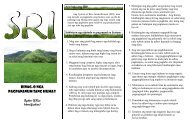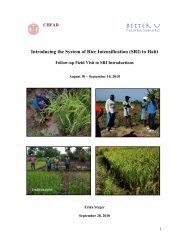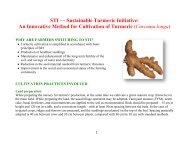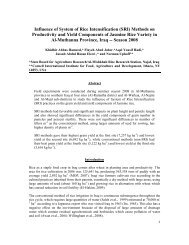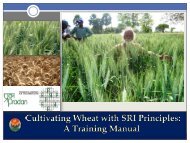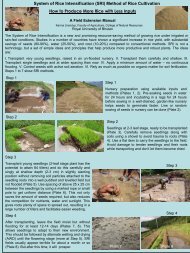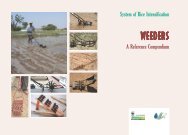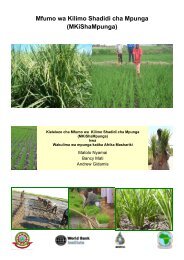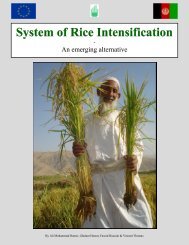EFFECT OF THE SYSTEM OF RICE INTENSIFICATION (SRI) ON ...
EFFECT OF THE SYSTEM OF RICE INTENSIFICATION (SRI) ON ...
EFFECT OF THE SYSTEM OF RICE INTENSIFICATION (SRI) ON ...
You also want an ePaper? Increase the reach of your titles
YUMPU automatically turns print PDFs into web optimized ePapers that Google loves.
e increased during times of flooding and slowly decrease when drained (Mitsuchi, 1974). There<br />
will however be a trade-off when considering the possibilities of denitrification and emissions of<br />
N2O. Intermittent flooding showed a 17% lower GWP for N2O and CH4 than continuous flooding in<br />
China (Yue et al., 2005) and thus the most favorable would seem to go for a fluctuating water table<br />
as with <strong>SRI</strong>.<br />
The emissions of N2O are quite large during the dry season – up to three to four times larger than<br />
upon the growth season (Dobermann & Fairhurst, 2000) upon aerobic conditions. Denitrification is<br />
occurring in situations of lack of oxygen and some bacterial strains will then use nitrate as a source<br />
of respiration in stead of oxygen (Patrick & Reddy, 1976). Denitrification can especially occur in<br />
wetland soils, poorly drained soils and soils fertilized with nitrate (Borggaard & Elberling, 2003).<br />
The theoretical <strong>SRI</strong> will give fewer rises to denitrification due to the fluctuating water table. The<br />
<strong>SRI</strong> practiced by farmers seems though however to experience some periods with denitrification<br />
due to the long drought periods and aerobic conditions.<br />
The farmers in Prey Veng do however not possess the means to control water, they are able to drain<br />
their fields but not adjust water levels later on. It is therefore very risky if they drain at one point<br />
and not are able to adjust water if a prolonged drought is present. Only 3% of the target farmers use<br />
less water, and their fields might in theory build up less C than fields that are flooded according to<br />
the findings of Mitsuchi (1974) but it is though doubtful if there will be any significant difference<br />
between their C levels and the other participating farmers. Especially when considering that one<br />
rice season is very short – a few months followed by a fallow period throughout the rest of the year.<br />
The farmers who are able to adjust water levels (3%) will though be able to reduce CH4 emissions<br />
due to drainage periods resulting in aerobic conditions (Wassmann et al., 2000; Yue et al., 2005;<br />
Zou et al., 2005; Li et al., (2009) but will at the same time increase emissions of N2O and CO2 and<br />
thereby creating a trade-off. The success of the drainage concepts is though depending on the<br />
degree of drainage i.e. complete drainage or as in the <strong>SRI</strong> theories soil is kept moist/wet to dry<br />
depending on the farmer and the area. If the soil is just a little too wet/moist there will still be<br />
methane emissions due to anaerobic conditions.<br />
The majority of farmers do as mentioned not adjust water levels and their “<strong>SRI</strong>” fields will emit<br />
more CH4 but less N2O and CO2 due to long periods with anaerobic conditions. The question is then<br />
which systems are to be preferred considering the present trade-off. Since few farmers use chemical<br />
66



